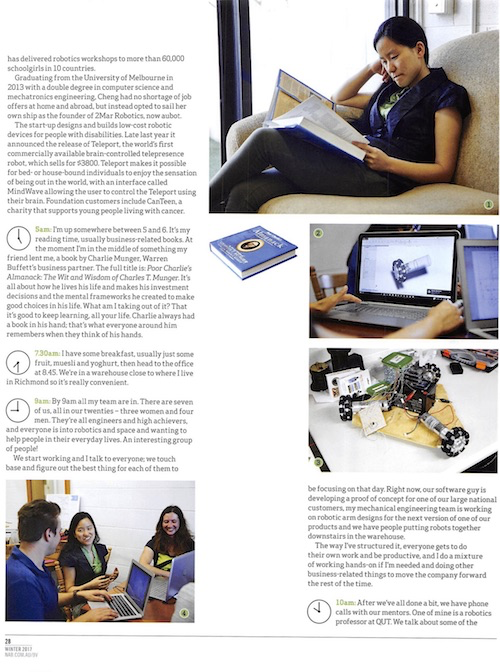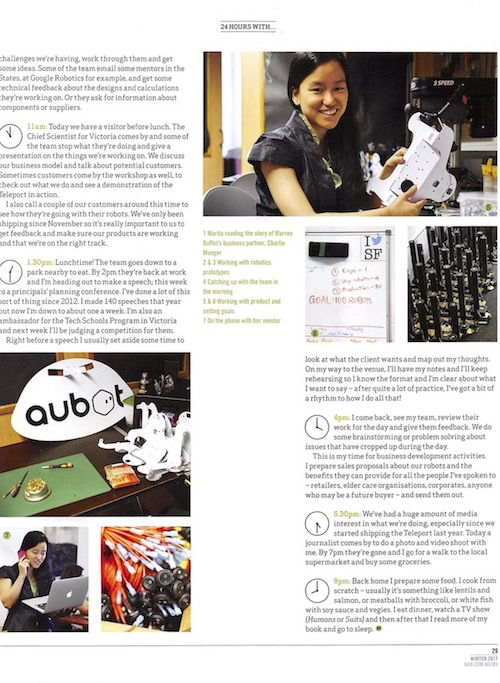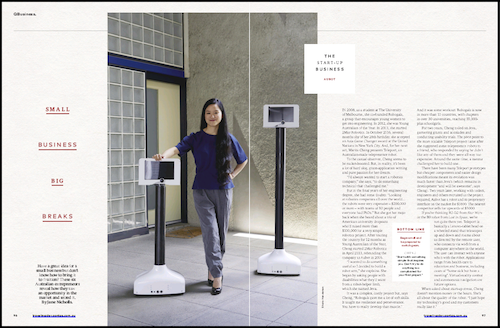- Published: Saturday, 25 November 2017
It’s so exciting seeing our robots make a difference in the lives of others. Six-year-old Freyja has a suppressed immune system, so coming into contact with other kids puts her life at risk. Our robot, Teleport, appeared on ABC News and the Project recently, showcasing Freyja going to school remotely, to give her the social experience, without making her sick.

(ABC News: Jon Healy)
If you know a child with cancer, longterm illness or disability missing school, get in touch and we may be able to supply them with a robot to go to school remotely, free of charge, with the robots generously provided by Missing School.
Here are the media mentions for you to see the robots in action:
The ABC’s Facebook post is here (over 130k views):
https://www.facebook.com/abcnews.au/videos/10157645132279988/
The ABC online article (with embedded social media piece) is here:
http://www.abc.net.au/news/2017-11-21/robo-classroom-helping-educate-seriously-ill-canberra-girl/9176204
Channel 10’s The Project (Thursday night). It starts at 1’45:
https://www.facebook.com/TheProjectTV/videos/10155114988643441/
Well done, Missing School, on your amazing mission, work, and for making this happen!

(ABC News: Jon Healy)
- Published: Saturday, 28 October 2017
My company, aubot, was recently invited to go to Queensland for 6 months, as part of Advance Queensland's Hot Desq program, to inspire local entrepreneurs, and to grow our business.
Here I am via Teleport in Melbourne, talking about how excited we are to be going to Queensland and working with QUT's Bluebox at the Foundry.
Welcome to #Qld @maritacheng @aubotRobotics! We hope you enjoy your #HotDesQ experience at @qutbluebox pic.twitter.com/k9wjRPcXyZ
— Advance Queensland (@AdvanceQld) October 5, 2017
Here's a Medium article on an interview I did with Advance Queensland talking about the company's move for 6 months.
And here I am, arriving in Brisbane with some Teleport components for the team to work with.
Arriving at @QUTfoundry with Teleport components #HotDesQ #startupstate @QUTmedia pic.twitter.com/GwE3t6kr3G
— Aubot (@aubotRobotics) October 27, 2017
- Published: Wednesday, 06 September 2017
I did an interview at the beginning of the year about 24 hours in the life of me. I've copied and pasted the text here below. Enjoy!

For robotics pioneer Marita Cheng, being named 2012 Young Australian of the Year was just the springboard to her new and now globally-recognised business: making life-changing robots for people with a disability.
Marita Cheng grew up in housing commission in Cairns, with a single mother who worked as a hotel cleaner to support her two children. Since being runner-up dux at her high school in 2006, Marita’s intellect, drive and capacity for hard work have led to a dizzying array of laurels.
She was named Young Australian of the Year in 2012, courtesy of her work as the founder of Robogals Global, a movement that encourages more girls into high tech and engineering careers. The organisation has delivered robotics workshops to more than 60,000 schoolgirls in 10 countries.
Graduating from the University of Melbourne in 2013 with a double degree in computer science and mechatronics engineering, Cheng had no shortage of job offers, at home and abroad, but instead opted to sail her own ship as the founder of 2Mar Robotics, now aubot. The start-up designs and builds low-cost robotic devices for people with disabilities. Late last year it announced the release of Teleport, the world’s first commercially available brain-controlled telepresence robot. Foundation customers include CanTeen, a charity which supports young people battling cancer.
5am: I’m up somewhere between 5 and 6. It’s my reading time, usually business-related books. At the moment I’m in the middle of something my friend lent me, a book by Charlie Munger, Warren Buffett’s business partner. The full title is: Poor Charlie's Almanack: The Wit and Wisdom of Charles T. Munger. It’s all about how he lives his life and makes his investment decisions and the mental frameworks he created to make good choices in his life. What am I taking out of it? That it’s good to keep learning, all your life. Charlie always had a book in his hand; that’s what everyone around him remembers when they think of his hands!
7.30am: I have some breakfast, usually just some canned fruit, muesli and yoghurt, then head to the office at 8.45. We’re in a warehouse close to where I live in Richmond so it’s really convenient.

9am: By 9am all my team are in. There are seven of us, all in our twenties – three women and four men. They’re all engineers and high achievers, and everyone is into robotics and space and wanting to help people in their everyday lives. An interesting group of people!
We start working and I talk to everyone; we touch base and figure out the best thing for each of them to be focusing on that day. Right now, our software guy is developing a proof of concept for one of our large national customers, my mechanical engineering team is working on robotic arm designs for the next version of one of our products and we have people putting robots together downstairs in the warehouse.
The way I’ve structured it, everyone gets to do their own work and be productive and I get to do a mixture of working hands-on if I’m needed and doing other business-related things to move the company forward the rest of the time.
10am: After we’ve all done a bit, we’ll have phone calls with our mentors. One of mine is a robotics professor at QUT. We might talk for an hour about some of the challenges we’re having, work through them and get some ideas. Or some of the team could email some mentors in the States, at Google Robotics for example, and get some technical feedback about the designs and calculations they’re working on. Or they’ll ask for information about components or suppliers.
11am: We often have a visitor before lunch. The chief scientist for Victoria might come by and some of the team will stop what they’re doing and give a presentation on the things we’re working on. We’ll discuss our business model and talk about potential customers they may be able to introduce us to. Sometimes prospective customers come by the workshop as well, to check out what we do and see a demonstration of the Teleport in action.
I’ll also call a couple of our customers around this time to see how they’re going with their robots. We’ve only been shipping since November so it’s really important to us to get feedback and make sure our products are working and that we’re on the right track.

1.30pm: Lunchtime! The team usually goes down to a park nearby to eat. By 2pm they’re back at work and I’m heading out to make a speech; this week to a principals’ planning conference. I’ve done a lot of this sort of thing since 2012. I made 140 speeches that year but now I’m down to about one a week. I’m also an ambassador for the Tech Schools Program in Victoria and next week I’ll be judging a competition for them.
Right before a speech I usually set aside some time to look at what the client wants and map out my thoughts. On my way to the venue, I’ll have my notes and I’ll keep rehearsing so I know the format and I’m clear about what I want to say – after quite a lot of practice, I’ve got a bit of a rhythm to how I do all that!
4pm: I come back, see my team, review their work for the day and give them feedback. We might do some brainstorming or problem solving about issues that have cropped up during the day.
This has also become my time for business development activities. I prepare sales proposals about our robots and the benefits they can provide for all the people I’ve spoken to – retailers, elder care organisations, corporates, anyone who may be a future buyer – and send them out.
5.30pm: We’ve had a huge amount of media interest in what we’re doing, especially since we started shipping the Teleport last year. I often have a journalist come by around this time to do a photo shoot or a video shoot with me. By 7pm they’re gone and I’ll go for a walk to the local supermarket and buy some groceries.
8pm: Back home I’ll prepare some food. I cook from scratch – usually it’s something like lentils and salmon, or meatballs with broccoli, or white fish with soy sauce and vegies. I’ll eat the food, watch a TV show like Humans or Suits and then after that I’ll read more of my book and go to sleep.
-----------------------------------------------------------------------------
Here's an example of a photo shoot or interview I would do. This one was for the QANTAS magazine.


- Published: Friday, 11 August 2017
A building collapse warning system, a pancreatic cancer detection kit and a self-inflating shirt to stop young children drowning if they fall into a pool. These aren’t the latest gadgets from Silicon Valley – they’re inventions dreamt up and built by high school students who saw a problem and decided to come up with a solution.
I’m an inventor too. An engineer, my company Aubot designs telepresence robots called ‘Teleport’ that trundle around on wheels for people who can’t get easily around – such as those in hospital, or those with a disability. But until the second half of Year 12, a career in engineering just wasn’t on my radar – I was on track to study medicine at university. The ‘Eureka!’ moment came during a four-day engineering camp I attended because I liked maths and science. I saw how robotics could change lives. From then, I was hooked.
This is why I’m stoked to be the ambassador of the Victorian Government’s Tech Schools initiative – and more than a little envious of the students that get to go to them. Unlike traditional technical schools, the 10 new Tech Schools are shared high-tech hubs that deliver innovative programs to students enrolled in partner secondary schools. This is important because Australia has plenty of room for improvement when it comes to participation, engagement and achievement in science, technology, engineering and mathematics (STEM) subjects – particularly girls.
The house of representatives’ standing committee on employment, education and training’s inquiry into innovation and creativity in the workplace heard some sobering figures, which they reported in May this year. Participation in STEM education at secondary school has dropped significantly over the past two decades and fewer students are reaching the highest levels in maths and science.
The Department of Industry, Innovation and Science noted the proportion of girls dropping mathematics after Year 10 shot up from 7.5% in 2001 to 21.5% in 2011. To encourage girls to stick with STEM, the inquiry heard, the language around those areas needs to change – for instance, to frame “engineering” as “making, doing, design thinking and being creative”. The inquiry also heard that one reason STEM participation drops overall in high school might be, in part, because students don’t see those subjects as relevant to everyday life. And this is a problem with long-term consequences. In 2015, the Australian Industry Group reported that the gap between what’s taught in schools and the skills needed by employers is widening.
Tech Schools aim to bridge that gap. Tech Schools design unique, high-tech programs with input from industry areas forecast for greatest growth. They’re also linked to the Victorian curriculum and what the students are learning at school. This means programs are relevant to students, allowing them to hone skills needed for jobs of the future – from problem-solving and creative thinking to using the latest technology.
The Yarra Ranges Tech School, which opened at the Box Hill Institute’s Lilydale Lakeside campus in April, is giving local students a taste of robotics, virtual reality and 3-D printing. The Monash Tech School, which will officially open in Term 3, offers programs that get students to find ways to help people with mobility issues – a topic particularly close to my heart. By mid-2018, all Tech Schools will be up and running, boosting STEM and problem-solving skills of students from more than 160 Victorian secondary schools.
If I attended a Tech School when I was in high school, I could have been inventing all through my teenage years. Sometimes I wonder: what could I have achieved if I started coding back in Year 7? Tech Schools will inspire current secondary school students like my engineering camp did me. Who knows what fantastic inventions they might hatch – and the lives they’ll change?
- Published: Tuesday, 25 July 2017
Car company Škoda decided that I am "brilliant not famous", and created this content piece video to show the strength of their convictions. :P
Teleport also makes an appearance! :)
Check out their campaign here: http://www.skoda.com.au/about/brilliant-not-famous
They also filmed a tv ad with wifi inventor Dr. John O’Sullivan, and a further content piece for young artist Aelita Andre.
About Me
 Forbes named me a world's top 50 woman in tech & 30 Under 30. I founded Robogals and Aipoly and was Young Australian of the Year 2012. Currently working on robotics company Aubot. I'm the youngest Member of the Order of Australia (AM) and I give speeches around the world.
Forbes named me a world's top 50 woman in tech & 30 Under 30. I founded Robogals and Aipoly and was Young Australian of the Year 2012. Currently working on robotics company Aubot. I'm the youngest Member of the Order of Australia (AM) and I give speeches around the world.
I tweet @maritacheng and I'm on Facebook.
Subscribe
Random Articles
-
Australian of the Year Awards 60th anniversary
My last, large, in-person networking event I went to in Australia since before the pandemic was the 60th anniversary celebrations for the Australian of the...
-
YouthActionNet Global Fellowship Day 6: Succession
We spoke about our succession plans today. We did a great activity: if I were to leave Robogals on November 6, one month from now, what would I...
-
Jevaroo’s base
Jevaroo’s base dual plates are weighted with three heavy batteries, two large stepper motors for the neck’s linear actuators and its own two steel...
-
Writing my memoirs
Today I asked myself, what do I want to have achieved in life by the time I’m 50? I wrote down all the major things I would be proud to have...
-
Why I wear odd socks
Whenever I go and collect my laundry from the laundry room and have to go back out into the hallway for my second load or to go to the toilet, I...
-
Live at Shell Eco-Marathon Asia
It's been full-on in Malaysia at Shell Eco-Marathon Asia. The most exciting thing has been tracking our Australian entrant, Girton Grammar Team...
-
Your work is never done
When I started Robogals, I thought going to schools and teaching girls robotics should get more to choose physics, chemistry and advanced maths;...
-
When to launch
I was thinking about my business idea and wondering when would be the right time to launch, if to launch and how. It was really doing my head in. I...
-
Delegating to not go crazy
If you're delegating tasks and then pulling your hair out over it, then you're probably not doing it right. Anything that's insanely great requires a team...
-
Playing with robots
Playing with robots in the office with Kyle van Dordrecht. We timed ourselves putting a robotics kit together... then we modified the kit.


